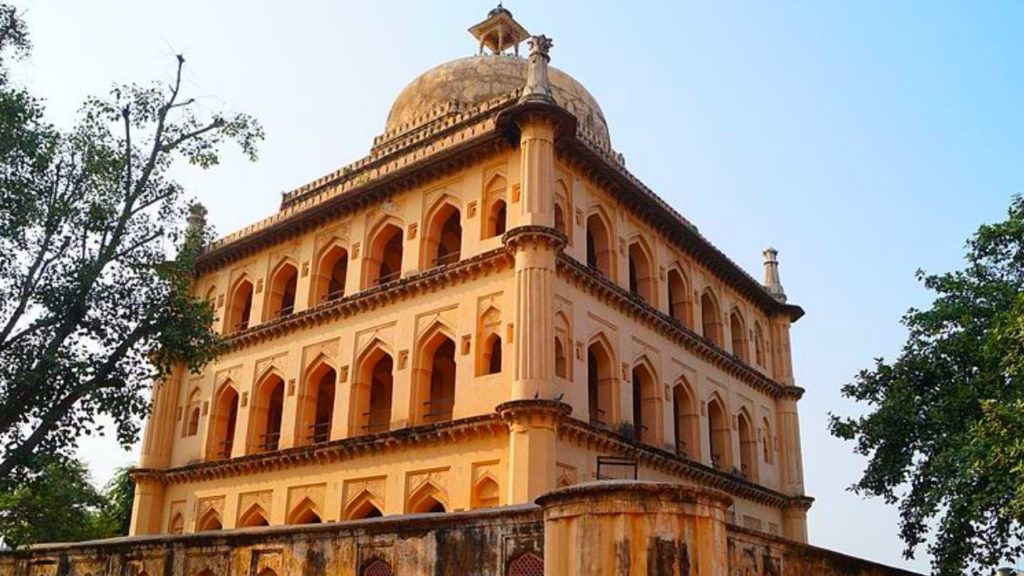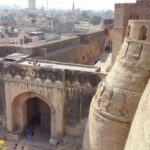Fateh Jang Gumbad: A Historical and Architectural Wonder in Alwar
Snuggled in the enchanting city of Alwar, Rajasthan, the Fateh Jang Gumbad stands as a testament to the region’s abundant historical and architectural heritage. This mausoleum, commonly overshadowed by the more popular forts and royal residences of Rajasthan, offers a peek into the magnificence and artistic success of Mughal architecture. Spanning a history of over four centuries, the Fateh Jang Gumbad showcases the detailed creativity and cultural combination characteristic of the period.
Historical Context
The Fateh Jang Gumbad, also known as the Tomb of Fateh Jang, was constructed in the early 17th century during the reign of the Mughal Emperor Jahangir. The tomb was developed for Fateh Jang, a notable noble and military general in the Mughal Empire. His contributions to the empire’s military campaigns and administrative reforms earned him a place of honor in Alwar, where this mausoleum was erected to celebrate his accomplishments and legacy.
Fateh Jang was a prominent figure who played a significant role in the Mughal administration and military strategies. His contributions were recognized by the Mughal court, leading to the construction of this mausoleum as a mark of respect and admiration. The Fateh Jang Gumbad stands as an icon of the Mughal Empire’s architectural and cultural expertise, blending Mughal sophistication with regional influences.
Architectural Significance
The Fateh Jang Gumbad is a quintessential example of Mughal architecture, showcasing the grandeur and sophistication for which the empire was renowned. The tomb’s design incorporates several distinctive aspects of Mughal architecture, including intricate carvings, symmetrical layouts, and elegant domes.
Design and Layout
The tomb is set within a garden, a common feature in Mughal mausoleums, symbolizing paradise on earth. The layout follows the traditional Mughal pattern of a square or rectangular enclosure with a central tomb, surrounded by lush gardens and water channels. This design not only enhances the aesthetic appeal of the structure but also reflects the Mughal emphasis on creating serene and harmonious spaces.
The Dome
The most striking feature of the Fateh Jang Gumbad is its grand dome. The dome is meticulously crafted, rising majestically above the tomb and serving as a focal point of the structure. The use of red sandstone and white marble in the construction of the dome highlights the Mughal preference for contrasting colors and materials to create visual impact.
Carvings and Ornamentation
The tomb is adorned with intricate carvings and decorative elements that exemplify the craftsmanship of Mughal artisans. The walls of the tomb are embellished with delicate floral patterns, geometric designs, and calligraphic inscriptions, reflecting the artistic sensibilities of the era. The use of inlay work, which involves embedding semi-precious stones into the stone surface, adds a touch of opulence to the structure.
Symmetry and Proportions
Mughal architecture is renowned for its emphasis on symmetry and proportion, and the Fateh Jang Gumbad is no exception. The tomb’s layout is meticulously planned to ensure that all elements are perfectly aligned and balanced. This attention to detail not only enhances the visual appeal of the structure but also underscores the Mughal commitment to architectural excellence.
Cultural and Historical Impact
The Fateh Jang Gumbad is more than just an architectural marvel; it is a reflection of the cultural and historical milieu of the Mughal Empire. The tomb stands as a reminder of the era’s artistic achievements and the fusion of various cultural influences that characterized Mughal architecture.
Cultural Fusion
The Fateh Jang Gumbad embodies the cultural fusion that was a hallmark of Mughal architecture. The use of regional materials and techniques alongside traditional Mughal elements demonstrates the blending of different artistic traditions. This fusion is a testament to the Mughal Empire’s openness to diverse cultural influences and its ability to integrate them into its architectural heritage.
Historical Significance
As a mausoleum dedicated to a prominent Mughal noble, the Fateh Jang Gumbad holds historical significance beyond its architectural beauty. The tomb serves as a tangible link to the Mughal Empire’s military and administrative history, providing insights into the life and contributions of Fateh Jang. It also offers a glimpse into the broader historical context of the era, reflecting the political and cultural dynamics of the time.
Preservation and Legacy
In recent years, efforts have been made to preserve and restore the Fateh Jang Gumbad, ensuring that this historical treasure continues to be a source of inspiration and admiration. The tomb’s preservation is crucial not only for maintaining its architectural integrity but also for safeguarding the cultural heritage of Alwar and the Mughal Empire.
Restoration Efforts
Restoration efforts have focused on repairing and conserving the tomb’s structural elements, as well as preserving its intricate carvings and decorative features. These efforts are essential for preventing further deterioration and ensuring that the tomb remains a significant cultural landmark for future generations.
Educational and Cultural Value
The Fateh Jang Gumbad serves as an important educational and cultural resource, offering visitors and scholars insights into Mughal architecture and history. Its preservation contributes to the broader understanding of the Mughal Empire’s architectural achievements and its impact on regional and global cultural landscapes.
Conclusion
The Fateh Jang Gumbad stands as a remarkable example of Mughal architecture and a significant cultural landmark in Alwar. Its grandeur, intricate design, and historical importance make it a valuable heritage site that reflects the artistic and historical legacy of the Mughal Empire. As efforts to preserve and protect this architectural marvel continue, the Fateh Jang Gumbad will remain a testament to the enduring beauty and significance of Mughal architecture.
For more information about visiting and exploring Rajasthan, consider checking out Rajasthan Tour Packages.
Q1.: What is the Fateh Jang Gumbad, and where is it situated?
A: The Fateh Jang Gumbad, likewise called the Burial place of Fateh Jang, is a historic mausoleum situated in the city of Alwar, Rajasthan, India. It stands as a considerable example of Mughal style and a testimony to the region’s abundant historical and social heritage.
Q2.: That was Fateh Jang, and why was the Fateh Jang Gumbad built?
A: Fateh Jang was a noticeable honorable and army general in the Mughal Realm during the very early 17th century. The Fateh Jang Gumbad was integrated in his honor during the regime of Mughal Emperor Jahangir to commemorate his payments to the empire’s army projects and administrative reforms.
Q3.: What architectural design is the Fateh Jang Gumbad understood for?
A: The Fateh Jang Gumbad is known for its Mughal architectural design. It features complex makings, balanced formats, and elegant domes, which are characteristic of Mughal layout. The mausoleum mixes Mughal elegance with local influences, creating a distinct architectural marvel.
Q4: Describe the format and layout of the Fateh Jang Gumbad?
A: The Fateh Jang Gumbad is established within a garden, following the Mughal practice of integrating lavish gardens and water channels to signify heaven. The format is generally square or rectangular, with a central burial place surrounded by yards. This layout boosts the aesthetic appeal and shows the Mughal emphasis on calm and harmonious spaces.
Q5.: What are some noteworthy functions of the Fateh Jang Gumbad?
A: Remarkable functions of the Fateh Jang Gumbad include its grand dome, crafted from red sandstone and white marble, which acts as a centerpiece. The tomb is likewise adorned with intricate makings, flower patterns, geometric layouts, and calligraphic engravings. The use of semi-precious rocks in inlay work includes a component of luxury.
Q6.: How does the Fateh Jang Gumbad mirror Mughal building concepts?
A: The Fateh Jang Gumbad shows Mughal building concepts through its emphasis on balance, percentage, and detailed craftsmanship. The format is meticulously planned to make certain best positioning and equilibrium, showcasing the Mughal commitment to building quality.
Q7.: What is the cultural and historic importance of the Fateh Jang Gumbad?
A: The Fateh Jang Gumbad holds cultural and historical significance as it represents the imaginative success of the Mughal Realm and the cultural blend of the period. It gives understandings into Mughal army and management history and reflects the broader political and social characteristics of the moment.
Q8.: What initiatives have been made to preserve the Fateh Jang Gumbad?
A: Efforts to protect the Fateh Jang Gumbad consist of repair initiatives concentrated on repairing and preserving its architectural elements and elaborate carvings. These efforts are critical for protecting against more deterioration and making certain the burial place remains a significant cultural landmark.
Q9.: Exactly How does the Fateh Jang Gumbad add to our understanding of Mughal style?
A: The Fateh Jang Gumbad acts as a crucial academic and social source, providing useful understandings right into Mughal style and history. Its preservation aids in comprehending the architectural success of the Mughal Realm and its effect on regional and global cultural landscapes.
Q10.: Why is the Fateh Jang Gumbad took into consideration a valuable heritage website?
A: The Fateh Jang Gumbad is thought about a valuable heritage site as a result of its magnificence, thorough design, and historic importance. It mirrors the artistic and historical legacy of the Mughal Realm, and its ongoing preservation guarantees that its building and cultural relevance endures for future generations.



